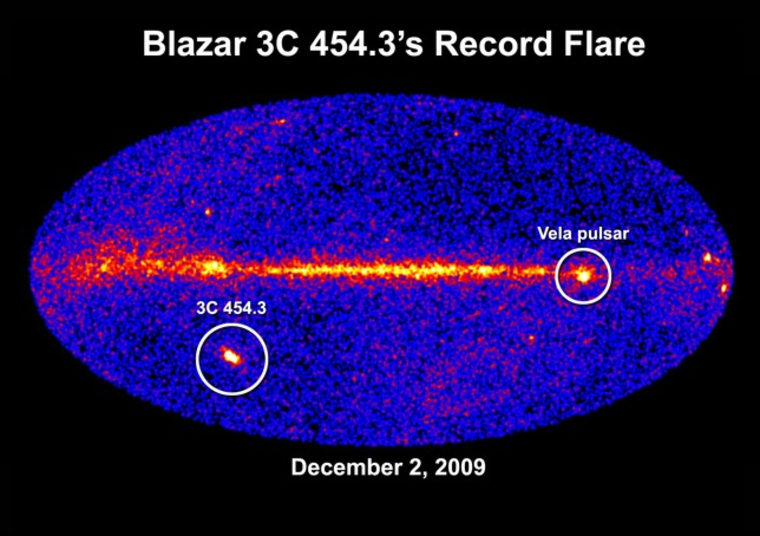A distant galaxy with a giant black hole in its center has been acting up recently, emitting extremely bright flashes of gamma ray light.
The flares began Sept. 15, making the galaxy currently the brightest source of gamma rays in the sky and boosting its own brightness to more than 10 times its regular luminosity over the summer. NASA's Fermi Gamma-ray Space Telescope has been observing the phenomenon to learn more about how such active galaxies work. Astronomers think this galaxy, identified as 3C 454.3, is what's called a blazar.
Blazars, like many active galaxies, emit oppositely directed jets of particles traveling near the speed of light when matter falls toward their central supermassive black holes. What makes a blazar so bright in gamma rays is its orientation in space. One of the jets happens to be aimed straight at us, so it is easy to spot when viewed from Earth.
"We're looking right down the barrel of a particle jet powered by the galaxy's supermassive black hole," said Gino Tosti at the National Institute of Nuclear Physics in Perugia, Italy. "Some change within that jet — we don't know what — is likely responsible for these flares."
This galaxy is located about 7.2 billion light-years away from Earth in the constellation Pegasus. Despite its distance, it is currently brighter than the Vela pulsar, a dense rotating star that is usually the brightest persistent source in the gamma-ray sky. But at about 1,000 light-years away, the Vela pulsar is relatively nearby in astronomical terms.
"3C 454.3 is millions of times farther away, yet the current flare makes it twice as bright as Vela," said Lise Escande at the Center for Nuclear Studies in Gradignan, near Bordeaux, France. "That represents an incredible energy release, and one the source can't sustain for very long."
According to Massimo Villata at Italy's Torino Observatory, 3C 454.3 also is flaring at radio and visible wavelengths, if less dramatically.
"In red light, the blazar brightened by more than two and a half times to magnitude 13.7, and it is also very bright at high radio frequencies," Villata said. The brightness of an object in the night sky is classified as its magnitude, with lower numbers referring to brighter objects.
The Fermi team is alerting other astronomers so they can monitor the event over as broad a range of wavelengths as possible. "That's our best bet for understanding what's going on inside that jet," Tosti said.
